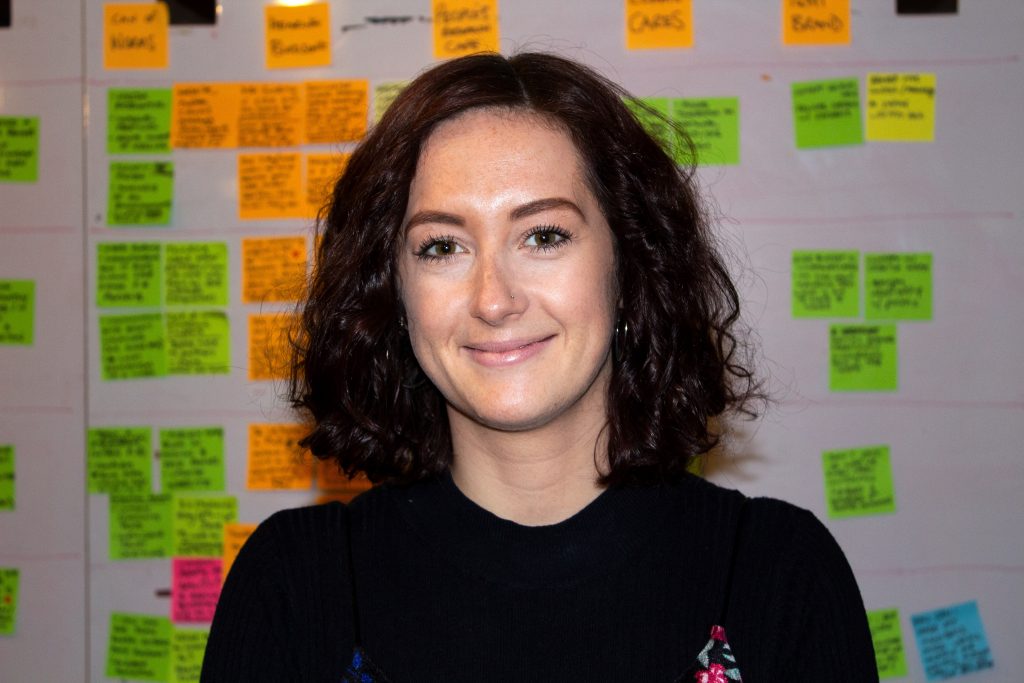
By Pip Batey, Design Strategist, Helix Centre, IGHI
I have always cared about social causes, particularly within mental health and environmental-related issues. I enjoy making sense of complex problems and taking concrete steps to improve systems that can have a lasting positive impact. Both of these elements are a core part of Helix’s ethos and ways of working.
Prior to joining the Helix Centre, I trained as a user experience designer at a digital product design agency. I then went on to work as an interaction designer for a range of digital healthcare startups. Taking this experience further, in 2018 I completed an MRes in Healthcare & Design at the Royal College of Art, where I focused on reducing anxiety in children awaiting surgery through creativity. During my time on the masters, I was taught by Lenny Naar, the Helix Centre’s Head of Design Strategy. It was then that I discovered the unique setup of Helix and IGHI.

In my role as a designer at Helix, I use techniques called human-centred design and service design to solve problems in healthcare. The mixture of these processes puts people’s needs, motivations and behaviours at the centre of the project while also considering the problem from a wider systems perspective. Zooming back and forth between these two viewpoints helps to inform and inspire creative methods to visualise solutions through prototypes, which help to break down complex problems in a tangible, accessible and engaging way. The final aspect of my role is to form an appropriate strategy in order to test these solutions in the real world with the goal of creating sustainable positive change.
Having the opportunity to connect with people on a meaningful level is the most rewarding part of my job. A core part of my role is to empathise, understand and balance the needs of everyone within the system. Therefore I end up meeting a diverse range of interesting people and learn about their personal stories. It’s a privilege to observe and be part of people’s lives, especially when they are going through a vulnerable transition.

Recently, my team and I created an immersive public exhibition called Can of Worms. This set out to tackle the complexity of sharing healthcare data through storytelling and playful discovery to capture and spark informed conversations. The exhibition consists of a series of physical “cans of worms”, containing fictional audio stories that visitors can open up and listen to. Each story gives an example of how healthcare data is used in a particular scenario and then highlights the benefits and risks.
Through the multiple Can of Worms exhibitions, we have successfully engaged around 1000 members of the public from diverse backgrounds, gathering information about hopes and fears of data sharing from around 400 of those. Our next steps are to take Can of Worms to a shopping centre in Hammersmith, below a council estate, planned for February 2020. We hope this will help us reach seldom-heard voices and understand more about their needs and concerns.
Being a designer in healthcare does have its challenges. It can be difficult when I’m working with a multidisciplinary team who have different objectives haven’t necessarily grasped the value of design within the academic world. You have to educate and advocate for your role as well as doing the job itself. It’s key to understand these different perspectives, align them through a vision of success and bring them on a journey without compromising on any aspect of the project.
Working at Helix has taught me a lot, especially how creativity can be used to strengthen human connections. From my experience, forming meaningful relationships with and between stakeholders and end-users is the key driver to successful outcomes, and one of the most important skills a designer can have.
My current focus is to create these meaningful relationships by challenging the current conventions of public engagement. I believe design methods can play a huge role in empowering diverse, vulnerable communities to be actively involved in research. They can also help align scientific research with societal challenges, closing the gap between academic institutes and the public.